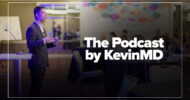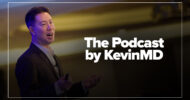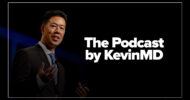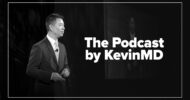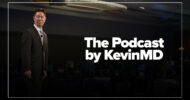Subscribe to The Podcast by KevinMD. Watch on YouTube. Catch up on old episodes!
Jeffrey Gladd shares his transformative journey from burnout to a thriving career in integrative medicine. Discover how shifting from treating symptoms to addressing whole-person care changed his life and practice. From battling burnout and personal health struggles to embracing nutrition, mindfulness, and movement, Jeffrey offers insights into creating a healthier, more balanced life—for physicians and patients alike. This episode uncovers the practical strategies and mindset shifts that empower health care professionals to reclaim their passion and provide better care.
Jeffrey Gladd is a family physician.
He discusses the KevinMD article, “From burnout to breakthrough: Why treating yourself like a patient could save your medical career.”
Our presenting sponsor is DAX Copilot by Microsoft.
Do you spend more time on administrative tasks like clinical documentation than you do with patients? You’re not alone. Clinicians report spending up to two hours on administrative tasks for each hour of patient care. Microsoft is committed to helping clinicians restore the balance with DAX Copilot, an AI-powered, voice-enabled solution that automates clinical documentation and workflows.
70 percent of physicians who use DAX Copilot say it improves their work-life balance while reducing feelings of burnout and fatigue. Patients love it too! 93 percent of patients say their physician is more personable and conversational, and 75 percent of physicians say it improves patient experiences.
Help restore your work-life balance with DAX Copilot, your AI assistant for automated clinical documentation and workflows.
VISIT SPONSOR → https://aka.ms/kevinmd
SUBSCRIBE TO THE PODCAST → https://www.kevinmd.com/podcast
RECOMMENDED BY KEVINMD → https://www.kevinmd.com/recommended
GET CME FOR THIS EPISODE → https://www.kevinmd.com/cme
I’m partnering with Learner+ to offer clinicians access to an AI-powered reflective portfolio that rewards CME/CE credits from meaningful reflections. Find out more: https://www.kevinmd.com/learnerplus
Transcript
Kevin Pho: Hi, and welcome to the show. Subscribe at KevinMD.com/podcast. Today we welcome Jeffrey Gladd. He’s a family physician. Today’s KevinMD article is “From burnout to breakthrough: Why treating yourself like a patient could save your medical career.” Jeffrey, welcome to the show.
Jeffrey Gladd: Thanks, Kevin. It’s great to be here.
Kevin Pho: All right, so your article talks a little bit about your story. Maybe we could start there. Tell us what this article is about, a little bit about your story and journey, for those who didn’t get a chance to read your KevinMD piece.
Jeffrey Gladd: Yeah, sure. So this spans 18 years. I came out as a solo family practice doc, you know, doing full-spectrum care: obstetrics, GI procedures, inpatient medicine, 40 patients a day. I didn’t even realize the level of burnout and unhealth that I was living in and sort of had an aha moment to take care of myself, focusing on nutrition first. Within six months, I lost 50 pounds and got off of the SSRIs I was self-medicating with for panic attacks since medical school. I really had this personal transformation that led me to then study what happened to me, do a deep dive into nutrition, and understand the other aspects of lifestyle that I didn’t get educated on—like mindfulness, nutrition—and then went into integrative medicine training at the University of Arizona.
I began to understand that there’s an entire discipline of care delivery based on these principles that, again, I didn’t learn, and most of us didn’t learn. That transformation in my career led me to start talking to patients about some of these topics, and their interest and desire to learn more drove me to then change my practice toward a more lifestyle-first focus, really digging deeper. Now, 15 years later in practice, I just keep seeing that we really need to drive practitioners to understand these pieces. I still don’t see us getting it in medical education, but patient demand is growing. The article was an attempt to inspire physicians to think, “Physician, heal thyself first,” and see if we can use these core principles to build on.
Kevin Pho: So you said that you were practicing for 16 years as a family physician, doing it all. Tell me what you were feeling—the symptoms you were experiencing—that led you to this more lifestyle approach. What made you feel like you were burning out after those 16 years of practice?
Jeffrey Gladd: Yeah, I mean, it was sort of a compounding effect. My panic attacks started in a surgery room in my third year of medical school. I didn’t know what was going on. It bordered on me leaving medical school. Eventually, I understood, “OK, let me see if I can medicate this,” and I started there. Then the burnout side was just the mental and emotional overwhelm of starting a solo practice and being burdened by the financial aspects, trying to see all of these patients and do all my clinical duties.
Sleep became a huge problem—trouble falling asleep, trouble staying asleep. My lack of energy was catching up with me. I kept seeing all these things adding up, and I just couldn’t function. I actually took a path of thinking, “Maybe if I lose weight, that’s the way to go,” and that’s where nutrition kind of started for me, more from a weight loss focus. But what I learned on the back end was it was way more important than weight loss. It was energy, it was getting good sleep, it was being able to get off of medication because, mentally and emotionally, I was significantly improved. So that was the big aha.
Kevin Pho: I just want to dig down deep in terms of what some of the exact changes were that you made in your own lifestyle—not only to, of course, lose the weight, but also achieve all these other beneficial effects. What specific changes did you make?
Jeffrey Gladd: Specifically, I really sort of understood the value of whole foods and worked in partnership with my wife to clean up the pantry, start shopping at the farmers’ market, and find quick and convenient meals based on whole foods—meats, eggs, nuts, fruits, and vegetables. Even that, which seems obvious, wasn’t for a busy lifestyle. I had to stay away from the rep dinners and rep lunches and focus on homemade food.
From a sleep perspective, I embraced the basics like making sure the room is dark, having a consistent routine, and staying off screens at bedtime—really building up to a good night’s sleep. Exercise became really important. I started out as a runner—my exercise of choice—and then really understood the importance of strength training. That was another big unlock: bringing more strength training into my routine. But fitting that into a schedule is hard, so I started with the basic seven-minute workout. I refer patients to the New York Times article on it, and Johnson & Johnson has an app for it. Seven minutes a day of movement is significant when you’re not moving at all and sitting at a desk or just moving from office to office.
Then, later on, I brought in the mindfulness component by finding one of the apps and really dedicating and scheduling 15 minutes a day to just press pause. Sometimes that meant just stepping out, turning my car on, and sitting in the car in the parking lot for 15 minutes. But really pressing pause in the middle of the day was a big piece of getting through and feeling sharp and connected with patients.
Kevin Pho: So, specific to your burnout that you were having midcareer, how did this 180 in your lifestyle address and improve your burnout?
Jeffrey Gladd: My mental sharpness improved, my mental energy improved, but I think the big piece for me was that as I started to share this with patients—without necessarily diving into my personal story—simply by asking, “Hey, what have you been eating? How are you sleeping? How are you managing stress? Where does your stress come from?” I found that patients were intrigued by these questions. Their eyes would light up. So my day, my relationship with patients, improved, and that’s really what pulled me out of the whole burnout side.
Kevin Pho: What is your practice like now? Is it a full integrative practice, where you specifically and exclusively focus on lifestyle and wellness? Or is it a little bit of a blend of what you traditionally did?
Jeffrey Gladd: I would say it’s more of a soft primary care practice. We have patients we maintain long-term relationships with, but it really starts out with a deep dive on the core foundational aspects a patient is doing, thinking about a whole-person view. We have a long intake form that walks them through diet, sleep, where their stress comes from, etc. Then I also pair that with a health coach, who is managing a lot of the consultation around movement, mindfulness, and nutrition, so that I can focus more on the deeper aspects of health, whether it’s medication or diagnostics. That’s what the practice looks like today—more of an integrative, full-spectrum, but also collaborative approach with a health coach on the team.
Kevin Pho: As you know, I’m an internal medicine primary care doctor, still in a relatively traditional model. I see patients every 15 minutes for follow-ups, 20 minutes for a physical sometimes. What are some easy wins that I can implement from a lifestyle and wellness standpoint? Obviously, I don’t have a dedicated practice like yourself, but for other doctors like me, with such limited time, what are some easy wins we can implement in the exam room in a typical 15- to 20-minute visit that you used to have?
Jeffrey Gladd: Yeah, it’s a great question, and it’s a big problem. I think it starts by simply asking some questions about the patient’s lifestyle and understanding the connections between their chronic condition or what they’re trying to prevent and the lifestyle choices they’re making—just highlighting the potential connections. That’s about all you can do in 15 minutes.
Other things I’ve seen work, and that I’ve done, is having a collaborative team—whether that’s a health coach or a dietitian—or being able to refer out locally on the fitness side of things. We don’t necessarily have that training or time, but highlighting lifestyle is important. I find that patients come to me and still say that their primary care docs or specialists aren’t asking about this or even say it doesn’t matter. I think that’s just wrong. So, highlight for the patient that lifestyle plays a role: “I’m not going to solve that for you in 15 minutes. Let me set you up with a collaborative team that I work with.”
Another thing that drives a lot of energy for practitioners moving into this whole-person care world is group appointments. Bring eight to 12 patients together, maybe around a specific theme—type 2 diabetes, prediabetes, inflammation-related conditions—and have a 60- to 90-minute presentation and discussion about lifestyle. That can fit into the reimbursement model and build community within the practice.
Kevin Pho: You mentioned a couple of times the lack of lifestyle training that most physicians have. You had the conventional training, then you went to Arizona and had a lifestyle training experience. If you could implement something in our traditional medical curriculum that we’re not currently getting—having been on both sides—what would that be?
Jeffrey Gladd: I think we really need to do a better job of teaching whole-food nutrition, its importance, and how to guide a patient in understanding that piece. It may actually end up being a self-care education path for all medical students to help them take care of themselves. Because that’s what I wish I’d had: an understanding of the role of lifestyle, nutrition, mindfulness, and sleep in my busy med school schedule with all-nighters, but making sure to find time to carve out that foundation. Then as you get into training, how can you maintain some semblance of that? Again, the whole message of that article was, “Physician, heal thyself.” If we can teach practitioners these skills early, I think it really sets us up to provide more of this connection to our patients.
Kevin Pho: I talk to a lot of physicians who are where you were after 16 years of practice. They’re burnt out. They often say they want a way out of medicine. What solutions or tips could you share with these burnt-out physicians who may be so burned out that they’re looking outside of medicine? Is there a way for them to turn around just like you did?
Jeffrey Gladd: Gosh, I certainly hope so, Kevin. We really need something to happen to drive that change. Again, I think it has to start with looking in the mirror and evaluating that practitioner’s lifestyle, then making one small change. Maybe that’s a personal journey of learning and application. I’d encourage seeking someone locally who specializes in nutrition or a health coach or someone who’s an expert in fitness and actually carve out some time. That might mean one, two, or three fewer patient visits a day, depending on your employment situation, which might be hard to do. But can you carve out some time for yourself, which becomes critical for longevity in your practice and for finding enjoyment in it?
So I really think finding a guide to help you understand and apply it to yourself may become that referral team or the collaborative teammate that you then send patients to over time.
Kevin Pho: You mentioned coaching a few times. I recall a New York Times article talking about how coaching is still relatively foreign in medicine, yet we do high-performance things all the time. Tell us about the role of coaching as you evolved through your practice.
Jeffrey Gladd: I’ve found that having a health coach in our practice is huge for patients—to have that resource for the lifestyle side of things. There are a number of great health coaching education centers offering a couple of years of training. Finding a coach who understands their level and doesn’t overstep their expertise is key, which is why, if you’re the physician, seeing one yourself as a patient is valuable. You learn they can really help someone clean up the pantry. I’ve had my health coach take patients to the grocery store to explain what to look for and how to read food labels. They can clarify supplementation options, talk about the basics of sleep and mindfulness. They can be that connector to the patient, while the physician stays at a higher level, taking care of things they trained for and are experts in.
Kevin Pho: We’re talking to Jeffrey Gladd, a family physician. Today’s KevinMD article is “From burnout to breakthrough: Why treating yourself like a patient could save your medical career.” Jeffrey, let’s end with some take-home messages that you want to leave with the KevinMD audience.
Jeffrey Gladd: Yeah, again, I think the take-home message is that it’s clear lifestyle and helping our patients connect their lifestyle to their health concerns is critical. Patients are getting information from everywhere, and one of the big opportunities we have as physicians is that patients still want practitioner guidance. They’re all lost in the mix of messaging, podcasts, books, and celebrities, and they don’t want to do this alone.
As a physician, taking a personal journey to improve your own health will help alleviate your burnout, but it also allows you to be the guide patients really desire. If you can’t handle that yourself in the 15-minute office visit or in your busy practice, find a team of coaches or dietitians who can unlock that piece, improve your relationships with patients, and grow your practice in a positive, enjoyable way.
Kevin Pho: Jeffrey, thank you so much for sharing your story, time, and insight, and thanks again for coming on the show.
Jeffrey Gladd: Thanks, Kevin. Great to see you.









